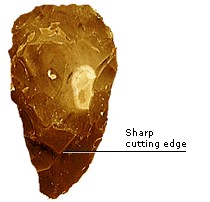DK Nature: Evolution
Living things gradually change over many generations in a process called evolution. Evolution ensures that organisms are fully adapted to their surroundings, and gives rise to new species, as well as making others extinct. The driving force for evolution is NATURAL SELECTION.
Evolutionary clues are found in fossils, the ancient remains of organisms. Creatures alive today share some characteristics with fossil ancestors, but have evolved new ones as well. Fossils also show that millions of living and extinct species evolved from a few simple organisms that lived billions of years ago.
A species is a group of similar living things, such as lions, that can breed together. If a group of individuals within a species becomes separated from all the other groups of that species, they can no longer breed with them. In time, the group evolves separately and becomes increasingly different. Eventually, it is so different that it becomes a new species.
Evolution is a continuous process of change. Change can be very rapid in small organisms, such as bacteria, but in most living things it takes thousands of years. HUMAN EVOLUTION from an apelike ancestor took millions of years and gave rise to several different species, not just our own.
Living things produce more offspring than they need to replace themselves. Only the few that are well adapted to their particular environment will survive. Thanks to this natural selection, the features needed to survive are passed on to their offspring and become more widespread, so a species gradually evolves.
Certain individuals have features that let them compete better for food, water, shelter, or mates. These fitter individuals are more likely to survive, breed, and pass on their advantageous features to their offspring. In this way, natural selection ensures the survival of the fittest. Naturalist Charles Darwin believed that this is how species evolve over time.
Between 1831 and 1836 naturalist Charles Darwin sailed around the world, describing the animals and plants he saw. This trip convinced him that living things evolved, even though most scientists believed that they remained the same. In 1859, he published his theories in On the Origin of Species.
Early humans evolved in Africa about five million years ago, from apelike ancestors. As these ancestors moved from dense forests to open woodlands, they evolved new features, such as the ability to walk upright.

Over 200,000 years old, this flint hand ax shows that early humans had evolved the skills to make and use tools. Its sharp edge may have been used to skin animals.
Walking on two legs enabled early humans to use their hands to pick up, carry, and use objects. Standing upright also allowed them to survey their surroundings, and look out for prey or enemies. These new abilities led to the evolution of larger brains, which allowed them to think, plan, and communicate.
